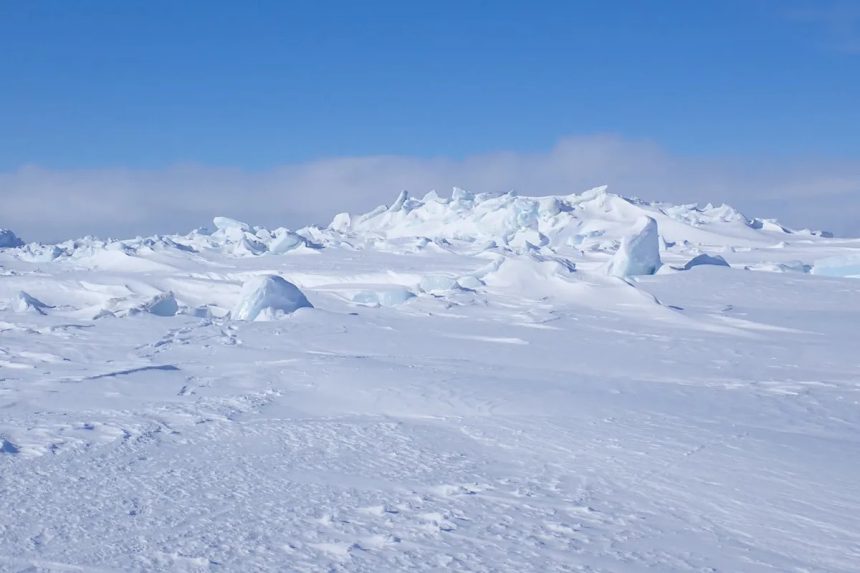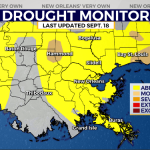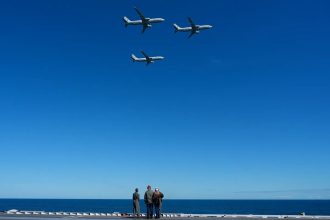As I walked out onto the frozen Arctic water off Utqiagvik, Alaska, for the first time, I was mesmerized by the icescape.
Piles of blue and white sea-ice rubble several feet high gave way to flat areas and then rubble again. The snow atop it, sometimes several feet deep, hides gaps among the blocks of sea ice, as I found out when one of my legs suddenly disappeared through the snow.
As a polar climate scientist, I have focused on Arctic sea ice for over a decade. But spending time on the ice with people who rely on it for their way of life provides a different perspective.
Local hunters run snowmobiles over the sea ice to reach the whales and seals they rely on for traditional food. They talked about how they know when the sea ice is safe to travel on, and how that’s changing as global temperatures rise. They described worsening coastal erosion as the protective ice disappears earlier and forms later. On land, they’re contending with thawing permafrost that causes roads and buildings to sink.
Their experiences echo the data I have been working with from satellites and climate models.
Most winters, sea ice covers the entire surface of the Arctic Ocean basin, even extending into the northern North Atlantic and North Pacific. Even in late summer, sea ice used to cover about half the Arctic Ocean. However, the late summer ice has declined by about 50% since routine satellite observations began in 1978.

This decline of summer sea ice area has a multitude of effects, from changing local ecosystems to allowing more shipping through the Arctic Ocean. It also enhances global warming, because the loss of the reflective white sea-ice surface leaves dark open water that absorbs the Sun’s radiation, adding more heat to the system.
What coastal communities are losing
Along the Alaskan coast, the decline of the Arctic sea ice cover is most apparent in the longer ice-free season. Sea ice is forming later in the fall now than it used to and breaking up earlier in the spring.
For people who live there, this means shorter seasons when the ice is safe to travel over, and less time when sea ice is present to protect the coastline from ocean waves.

Open water increases the risk of coastal erosion, particularly when accompanied by thawing permafrost, stronger storms and rising sea level. All are driven by greenhouse gas emissions from human activities, particularly burning fossil fuels.
In some places along the Alaskan coast, erosion threatens roads, houses and entire communities. Research has shown that coastal erosion in Alaska has accelerated over recent decades.
More weeks of open water also affect animals. Polar bears spend the summer on land but require sea ice to hunt their preferred food, seals. The longer the sea ice stays away from land, the longer polar bears are deprived of this high-fat food, which can ultimately threaten the bears’ survival.
The ice is also thinning and getting younger
Across the Arctic, satellite data has captured how sea ice has been thinning and getting younger.
As recently as the late 1970s, about 60% of the Arctic sea ice was at least 1 year old and generally thicker than younger ice. Today, the amount of ice more than a year old is down to about 35%.

Local residents experience that change in another way: Multiyear sea ice is much less salty than new sea ice. Hunters used to cut blocks of multiyear sea ice to get drinking water, but that older ice has become harder to find.
Sea ice forms from ocean water, which is salty. As the water freezes, the salt collects in between the ice crystals. Because the higher the salt content, the lower the freezing point of the water, these enclosures in the sea ice contain salty liquid water, called brine. This brine drains out of the sea ice over time through small channels in the ice. Thus, multiyear sea ice, which has survived at least one melt cycle, is less salty than first-year sea ice.
Since the coastal landfast sea ice around Utqiagvik no longer contains much multiyear sea ice, if any, the hunters now have to take a block of lake ice or simply gallon jugs of water with them if they plan to stay on the ice for several days.
Why data shows a continuing decline
As long as greenhouse gas emissions continue to increase, Arctic sea ice will generally continue to decline, studies show. One study calculated that, statistically, the average carbon dioxide emissions per person per year in the U.S. led to the disappearance of an area of summer sea ice the size of a large hotel room – 430 to 538 square feet (40 to 50 square meters) each year.
Today, when Arctic sea ice is at its minimum extent, at the end of summer, it covers only about half what it covered in 1979 at that time of the year. The Arctic still has around 1.8 million square miles (4.6 million square kilometers) of sea ice that survives the summer melt, approximately equal to the area of the entire European Union.

Climate models show the Arctic could be ice-free at the end of summer within decades, depending on how quickly humans rein in greenhouse gas emissions.
While a win for accessibility of shipping routes through the Arctic in summer, studies suggest that the large reduction of sea ice would bring profound ecological changes in the Arctic Ocean, as more light and heat enter the ocean surface.
The warmer the surface ocean water is, the longer it will take for the ocean to cool back down to the freezing point in the fall, delaying the formation of new sea ice.
What now?
Arctic sea ice will continue to form in winter for the next several decades. The months of no sunlight mean it will continue to get very cold in winter, allowing sea ice to form.

Climate models have estimated that it would take extremely high atmospheric carbon dioxide concentrations to warm the climate enough for no sea ice to form in the winter in the Arctic Ocean – close to 2,000 parts per million, more than 4.5 times our current level.
However, winter sea ice will cover less area as the Earth warms. For people living along the Arctic Ocean coast in Alaska, winter ice will still return for now. If global greenhouse gas emissions are not reduced, though, climate models show that even winter sea ice along the Alaskan coast could disappear by the end of the 21st century.
This article is republished from The Conversation, a nonprofit, independent news organization bringing you facts and trustworthy analysis to help you make sense of our complex world. It was written by: Alexandra Jahn, University of Colorado Boulder
Read more:
Alexandra Jahn receives funding from the National Science Foundation.









